英语宾语补足语用法详解(汇编)
宾语补足语讲解(整理)
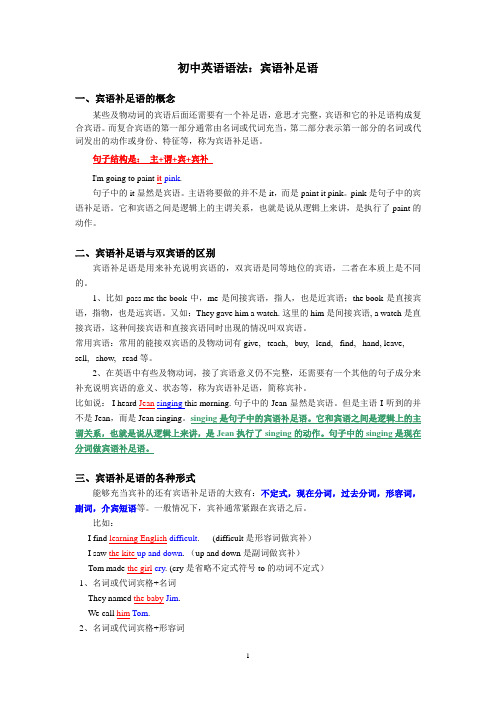
初中英语语法:宾语补足语一、宾语补足语的概念某些及物动词的宾语后面还需要有一个补足语,意思才完整,宾语和它的补足语构成复合宾语。
而复合宾语的第一部分通常由名词或代词充当,第二部分表示第一部分的名词或代词发出的动作或身份、特征等,称为宾语补足语。
句子结构是:主+谓+宾+宾补I'm going to paint it pink.句子中的it显然是宾语。
主语将要做的并不是it,而是paint it pink。
pink 是句子中的宾语补足语。
它和宾语之间是逻辑上的主谓关系,也就是说从逻辑上来讲,是执行了paint的动作。
二、宾语补足语与双宾语的区别宾语补足语是用来补充说明宾语的,双宾语是同等地位的宾语,二者在本质上是不同的。
1、比如pass me the book中,me是间接宾语,指人,也是近宾语;the book是直接宾语,指物,也是远宾语。
又如:They gave him a watch. 这里的him 是间接宾语, a watch 是直接宾语,这种间接宾语和直接宾语同时出现的情况叫双宾语。
常用宾语:常用的能接双宾语的及物动词有give, teach, buy, lend, find, hand, leave, sell, show, read等。
2、在英语中有些及物动词,接了宾语意义仍不完整,还需要有一个其他的句子成分来补充说明宾语的意义、状态等,称为宾语补足语,简称宾补。
比如说: I heard Jean singing this morning. 句子中的Jean显然是宾语。
但是主语I听到的并不是Jean,而是Jean singing。
singing 是句子中的宾语补足语。
它和宾语之间是逻辑上的主谓关系,也就是说从逻辑上来讲,是Jean执行了singing的动作。
句子中的singing是现在分词做宾语补足语。
三、宾语补足语的各种形式能够充当宾补的还有宾语补足语的大致有:不定式,现在分词,过去分词,形容词,副词,介宾短语等。
宾语补足语
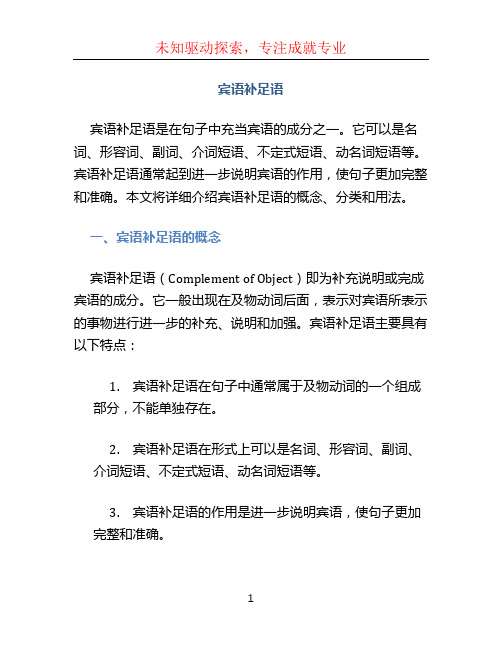
宾语补足语宾语补足语是在句子中充当宾语的成分之一。
它可以是名词、形容词、副词、介词短语、不定式短语、动名词短语等。
宾语补足语通常起到进一步说明宾语的作用,使句子更加完整和准确。
本文将详细介绍宾语补足语的概念、分类和用法。
一、宾语补足语的概念宾语补足语(Complement of Object)即为补充说明或完成宾语的成分。
它一般出现在及物动词后面,表示对宾语所表示的事物进行进一步的补充、说明和加强。
宾语补足语主要具有以下特点:1.宾语补足语在句子中通常属于及物动词的一个组成部分,不能单独存在。
2.宾语补足语在形式上可以是名词、形容词、副词、介词短语、不定式短语、动名词短语等。
3.宾语补足语的作用是进一步说明宾语,使句子更加完整和准确。
二、宾语补足语的分类根据宾语补足语所表示的内容,可以将宾语补足语分为以下几类:1. 名词性宾语补足语名词性宾语补足语是宾语的补足语是一个名词,用来对宾语进行进一步说明和补充。
常见的名词性宾语补足语有:•名词:我认为他是个天才。
•代词:我发现他是我。
•数词:他们选了三个代表。
2. 形容词性宾语补足语形容词性宾语补足语是宾语的补足语是一个形容词,用来对宾语进行进一步形容和补充。
常见的形容词性宾语补足语有:•形容词:我觉得那个电影很好看。
•分词:她把钱数得仔细。
•介词短语:他们把书放在桌子上。
3. 副词性宾语补足语副词性宾语补足语是宾语的补足语是一个副词,用来对宾语进行进一步说明和补充。
常见的副词性宾语补足语有:•副词:请你关好窗户。
•介词短语:他把字写在纸上。
4. 不定式宾语补足语不定式宾语补足语是宾语的补足语是一个不定式,用来对宾语进行进一步说明和补充。
常见的不定式宾语补足语有:•动词不定式:我打算去旅行。
•动词短语:她喜欢看电视。
5. 动名词宾语补足语动名词宾语补足语是宾语的补足语是一个动名词或者动词+ing形式,用来对宾语进行进一步说明和补充。
常见的动名词宾语补足语有:•动名词:我喜欢学习英语。
宾语补足语用法归纳
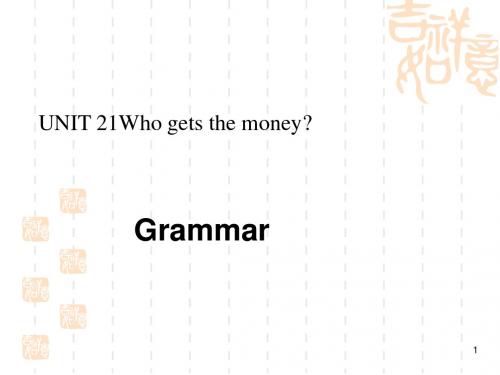
discover, find, keep, leave, show等。
The old men kept the children
amused with his stories.
老汉讲的故事使孩子们听的津津有味。 They covered him with a blanket only leaving his eyes exposed. 他们给他盖上毯子,只把他的眼睛露出。
9
宾语补足语
5.句式【Vt.+宾语+动词不定式的完成式】,常用于
此结构的动词是表示思维活动的动词,如:
believe, consider, imagine, think, know,
suppose, understand等。
We believe him to have gone abroad.
我们相信他已经出国了。 She thought you to have written to me. 她认为你已经给我写信了。
10
宾语补足语
▲现在分词可以在某些动词后面的复合宾语中做宾语 补足语,宾语为现在分词的逻辑主语。常用句式为: 【主语+Vt.+宾语+动名词(V - ing)】,现在分词作 宾语补足语时,有以下几种情况: 1.在某些感官动词后面,如:fell, hear, notice, observe, see, smell, watch, listen to, look at等, 表示宾语正在进行的动作或状态。 She could fell the tears coming. 她感到眼泪流了出来。
宾语补足语
3.表示某些意愿的动词,如:
desire, intend, mean, want, wish等。
什么是宾语补足语
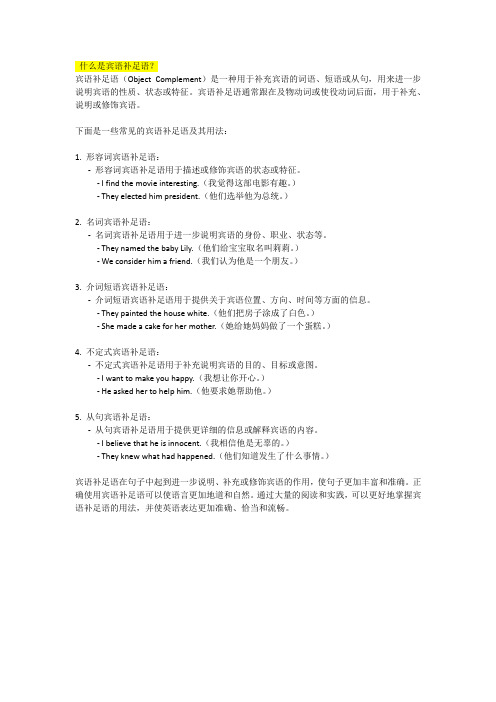
什么是宾语补足语?宾语补足语(Object Complement)是一种用于补充宾语的词语、短语或从句,用来进一步说明宾语的性质、状态或特征。
宾语补足语通常跟在及物动词或使役动词后面,用于补充、说明或修饰宾语。
下面是一些常见的宾语补足语及其用法:1. 形容词宾语补足语:-形容词宾语补足语用于描述或修饰宾语的状态或特征。
- I find the movie interesting.(我觉得这部电影有趣。
)- They elected him president.(他们选举他为总统。
)2. 名词宾语补足语:-名词宾语补足语用于进一步说明宾语的身份、职业、状态等。
- They named the baby Lily.(他们给宝宝取名叫莉莉。
)- We consider him a friend.(我们认为他是一个朋友。
)3. 介词短语宾语补足语:-介词短语宾语补足语用于提供关于宾语位置、方向、时间等方面的信息。
- They painted the house white.(他们把房子涂成了白色。
)- She made a cake for her mother.(她给她妈妈做了一个蛋糕。
)4. 不定式宾语补足语:-不定式宾语补足语用于补充说明宾语的目的、目标或意图。
- I want to make you happy.(我想让你开心。
)- He asked her to help him.(他要求她帮助他。
)5. 从句宾语补足语:-从句宾语补足语用于提供更详细的信息或解释宾语的内容。
- I believe that he is innocent.(我相信他是无辜的。
)- They knew what had happened.(他们知道发生了什么事情。
)宾语补足语在句子中起到进一步说明、补充或修饰宾语的作用,使句子更加丰富和准确。
正确使用宾语补足语可以使语言更加地道和自然。
通过大量的阅读和实践,可以更好地掌握宾语补足语的用法,并使英语表达更加准确、恰当和流畅。
英语中的宾语补足语

英语中的宾语补足语答:在英语中,为了使句子意思表达更加完整,在某些及物动词的宾语后面加上补充说明宾语的成分,称为宾语补足语。
其句型为:主语+谓语+宾语+宾语补足语。
充当宾语补足语的可以是名词、形容词、副词、介词短语和非谓语动词。
一、常接名词作宾语补足语的动词有:call,name,make,think等。
如:We should spare no efforts to make our country a developed country.二、常接形容词作宾语补足语的动词有:keep,make,keep,leave,find等,形容词作宾语补足语用于说明宾语的性质、状态或特征等。
如:You’d better leave the door open and let the fresh air in.三、副词作宾语补足语用来说明宾语所处的位置、状态等。
如:Please keep the fire on for a few more minutes.四、常接介词短语作宾语补足语的动词有:keep,find,leave,make等。
如:I left my pen on my desk at home.五、非谓语主要分为v-ing,done和to do 三种形式1.常接动词-ing形式作宾语补足语的动词有:感官动词see,watch,hear,notice,discover,feel,find等,使役动词have,get,leave,keep等后可以跟表示动作性质的现在分词作补足语,表示看见、注意到、发现某人正在做某事和让某人一直做某事。
如:In the country,we can hear birds singing.Don’t keep the child working on his lesson all day.2.接动词不定式作宾语补足语的动词有:ask,tell,want,teach,advise,allow,persuade,warn,cause,require,encourage等;有些感官动词和使役动词,如:see,watch,hear,feel,notice,observe,make,have,let等。
宾语补足语用法揭秘
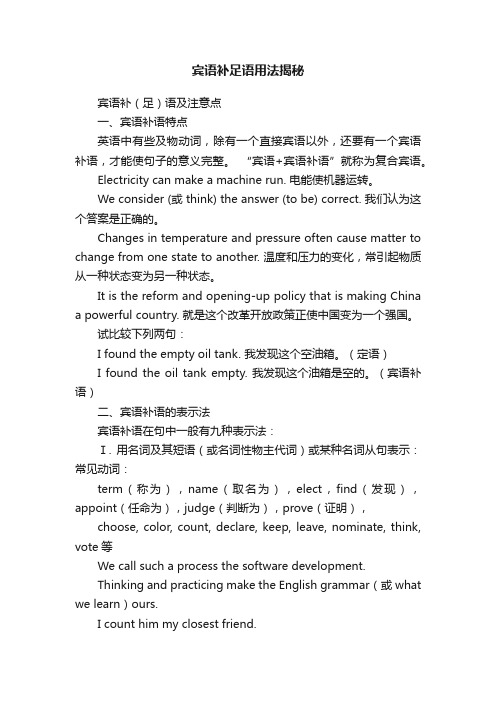
宾语补足语用法揭秘宾语补(足)语及注意点一、宾语补语特点英语中有些及物动词,除有一个直接宾语以外,还要有一个宾语补语,才能使句子的意义完整。
“宾语+宾语补语”就称为复合宾语。
Electricity can make a machine run. 电能使机器运转。
We consider (或 think) the answer (to be) correct. 我们认为这个答案是正确的。
Changes in temperature and pressure often cause matter to change from one state to another. 温度和压力的变化,常引起物质从一种状态变为另一种状态。
It is the reform and opening-up policy that is making China a powerful country. 就是这个改革开放政策正使中国变为一个强国。
试比较下列两句:I found the empty oil tank. 我发现这个空油箱。
(定语)I found the oil tank empty. 我发现这个油箱是空的。
(宾语补语)二、宾语补语的表示法宾语补语在句中一般有九种表示法:Ⅰ. 用名词及其短语(或名词性物主代词)或某种名词从句表示:常见动词:term(称为),name(取名为),elect,find(发现),appoint(任命为),judge(判断为),prove(证明),choose, color, count, declare, keep, leave, nominate, think, vote等We call such a process the software development.Thinking and practicing make the English grammar(或 what we learn)ours.I count him my closest friend.His father died young, leaving him an orphan.The sun set colored the sky a brilliant red.II. 用形容词及其短语表示:动词:beat, believe, boil, burn, color, count, drink, cut, declare, dye, feel, fill, hold(认为),leave, let, prefer, prove, render, set, shout, strike, talk, want, wish, think,see,have,keep,judge,wipe (如wipe… dry 将…擦干),wash(如wash… clean 将…洗干净),push(如 push the door open 把们推开),drink(如 drink a well dry 将井水喝干),hold(如hold… silent 使…安静)等。
宾语补足语讲解及练习

精心整理宾语补足语讲解一、定义:宾语补足语通常紧跟在宾语之后,对宾语进行补充说明。
二、句子结构是:主+谓+宾+宾补三宾语补足语的词语形式有:副词,形容,名词,介词短语,不定式(带to/不带to),分词(现在分词/过去分词)四、具体说明:(1)副词作宾语补足语如:Ifoundhim in yesterday.(2)形容词作宾语补足语如:Wemustkeepourclassroom clean.(3)名词作宾语补足语如:Wecallthem mooncakes.(4)介词短语作宾语补足语如:Ileftmypen onmydesk athome.(5)不定式作宾语补足语如:Sheoftenasksme tohelp her.Ioftenseehim play football.用不定式作宾语补足语的几种说明:①help后面作宾语补足语的动词不定式可以带to也可以不带to。
如:Ioftenhelpmymother(to)dosomehousework.②在使役动词和感官动词后作宾语补足语,不定式不带to。
这些动词有:一感:feel;二听:hear,listento;三让:let,have,make四观看:observe,see,watch,lookat如:I saw theboy climb thewall(过程)如:Theboss makes theboy work dayandnight.这类动词转为被动语态时,其后不定式符号to要重新加上去(注意have没有被动语态)。
Thoughhehadoften madehislittlesistercry,todayhe wasmadetocry byhislittlesister.虽然经常是他弄哭小妹妹,但今天他却被小妹妹弄哭了③表示心理状态的动词(consider,think,believe,discover,find,imagine,judge,suppose,prove等)后接不定式tobe+形容词或名词"结构作宾语补足语。
(完整版)非谓语动词作宾语补足语讲解与练习(修订版)
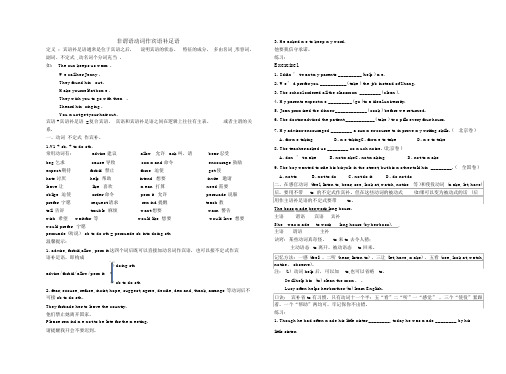
非谓语动词作宾语补足语定义:宾语补足语通常是位于宾语之后,说明宾语的状态、特征的成分,多由名词 ,形容词、副词、不定式 ,动名词个分词充当 .如: The sun keeps us warm .We call her Jenny .They found him out .Make yourself at home .They wish you to go with them .I heard him singing .You must get your hair cut .宾语 +宾语补足语 =复合宾语,宾语和宾语补足语之间在逻辑上往往有主表、或者主谓的关系.一、动词不定式作宾补。
1.V1 + sb. + to do sth.常用动词有:advise 建议allow 允许 ask 叫,请bear 忍受beg 乞求cause 导致command 命令encourage 鼓励expect 期待forbid 禁止force 迫使get 使hate 讨厌help 帮助intend 想要invite 邀请leave 让like 喜欢mean 打算need 需要oblige 迫使order 命令permit 允许persuade 说服prefer 宁愿request 请求remind 提醒teach 教tell 告诉trouble 麻烦want 想要warn 警告wish 希望wait for 等would like 想要would love 想要would prefer 宁愿persuade (劝说) sb to do sth = persuade sb into doing sth温馨提示:1.advise, forbid,allow, permit 这四个词后既可以直接加动名词作宾语,也可以接不定式作宾语补足语,即构成doing sthadvise/ forbid/ allow/ permitsb to do sth2.fear, excuse, refuse, insist, hope, suggest, agree, decide, demand, thank, arrange 等动词后不可接 sb to do sth。
- 1、下载文档前请自行甄别文档内容的完整性,平台不提供额外的编辑、内容补充、找答案等附加服务。
- 2、"仅部分预览"的文档,不可在线预览部分如存在完整性等问题,可反馈申请退款(可完整预览的文档不适用该条件!)。
- 3、如文档侵犯您的权益,请联系客服反馈,我们会尽快为您处理(人工客服工作时间:9:00-18:30)。
Contents
英语宾语补足语用法详解 (2)
一、概念 (2)
二、何时用现在分词、何时用过去分词作主语(宾语)补足语 (2)
三、可以用分词作主语或宾语补足语的动词 (3)
典例精析: (4)
英语宾语补足语用法详解
一、概念
分词作主语补足语和宾语补足语其实是同一成分用于两种不同的句式中。
具体地说,主动态句子中的宾语补足语就是被动态句子中的主语补足语。
先了解宾语补足语,则很容易了解主语补足语。
宾语补足语:在英语中,某些及物动词不仅需要宾语,而且还要求某个词或词组来补充说明宾语,即表示宾语代表的人或物所发出的动作或所处的状态,这个词或短语称为宾语补足语。
有些语法书把宾语和补足语称为复合宾语。
句型:及物动词+宾语(n./pron.)+宾语补足语(n./adj./adv./to do/-ing/-ed/介词短语共7种表示法)
该句型若变成被动语态,即将宾语提到句首作主语,原主动语态中的宾语补足语此时在被动语态中起到补充说明主语的作用,所以改称主语补足语。
例如:
A cook will be immediately fired if he is found smoking in the kitchen.
此句中smoking是主语he的补足语,所以称为主语补足语。
二、何时用现在分词、何时用过去分词作主语(宾语)补足语
分词作主语(宾语)补足语时,若主语(宾语)与分词之间是主动关系,则用现在分词表示主动;
如果主语(宾语)与分词之间是被动关系,则用过去分词表示被动。
例如:
He was heard singing in the next room.
He was singing.主语he与补足语“唱歌”之间是主动关系,故用现在分词singing。
One of the glasses was found broken.
One of the glasses was broken.主语one of the glasses与补足语“打破”之间是被动关系,故用过去分词broken。
Don‘t leave the water running while you brush your teeth.
The water is running.宾语the water与补足语“淌”之间是主动关系,故用现在分词running。
三、可以用分词作主语或宾语补足语的动词
要会使用分词作补足语,必须记住哪些动词可以接分词充当补足语。
1.感官动词feel,hear,listen to,see,watch,notice,observe,look at(一感二听五看)
及find等既可以接现在分词又可以接过去分词充当补足语。
如:
If you wave your book in front of your face,you can feel the air moving against your face.
The air can be felt moving against your face,if you wave your book in front of your face.
The next morning she found the man lying in bed,dead.
The next morning the man was found lying in bed,dead.
2.表示“致使”动词get,have,leave等既可以接现在分词又可以接过去分词充当补足
语。
--Good morning. Can I help you?
--I’d like to have the package weighed,madam.
3.表示“意欲;命令”的动词如like,want,wish,order等常接过去分词充当补足语。
如:
You must tell us exactly what you would like done.你必须准确地告诉我们该做什么。
The father wants his daughter taught the piano.这位父亲想让女儿学钢琴。
I wish it done quickly.我希望很快将此事做完。
注意:set,start,catch常跟现在分词作宾语补足语,make常跟过去分词作宾语补足语。
如:
Set sb.thinking,start sb.coughing,
He looked around and caught a man putting his hand into the pocket of a passenger.
The speaker raised his voice but still couldn’t make himself heard.
典例精析:
1.I smell something___________in the kitchen. Can I call you back in a minute?
A.burning
B.burnt
C.being burnt
D.to be burnt
答案:A。
解析:smell something burning“闻着什么东西在燃烧而发出糊味”强调这个动作正在进行。
burning作宾语补足语。
Something burnt“烧焦了的东西”表示一种状态。
所以选A。
2.After a knock at the door,the child heard his mother’s voice______him.
A.calling
B.called
C.being called
D.to call
答案:A。
解析:hear sb.doing sth.意为“听到某人在做某事”。
动词+ing表示主动,the child heard his mother’svoice calling him表示“孩子听见他母亲喊他”。
Hear sth.done表示“听见某事被做了”。
所以选A。
3.Jenny hopes that Mr.Smith will suggest a good way to have her written English_____in a short
period.
A.improved
B.improving
C.to improve
D.improve
答案:A。
解析:have sth.done表示“使某事被做”,have her written English improved“使她的书面英语得到提高”。
动词+ed形式作宾语补足语表示被动。
Have sb.doing sth.意为“使某人一直在做某事”表主动。
Have sb.do sth.意为“使某人做某事”表主动,do前必须省略to。
所以选A。
4.--Did Peter fix the computer himself?
--He______,because he doesn’t know much about computers.
A.has it fixed
B.had fixed it
C.had it fixed
D.fixed it
答案:C。
解析:have sth.done表示“使某事被做或请别人做某事”,动词+ed形式作宾语补足语表示被动。
由because he doesn’t know much about computers可判断出,他找别人维修了电脑。
所以选C。
